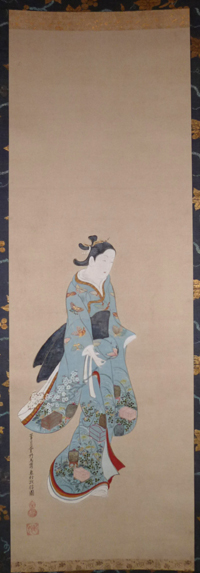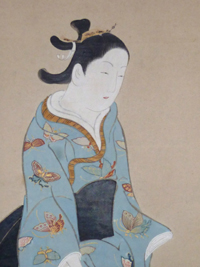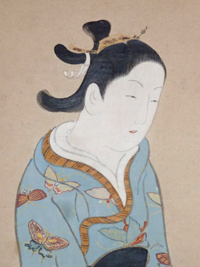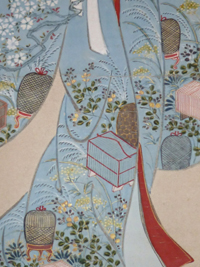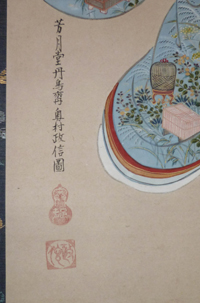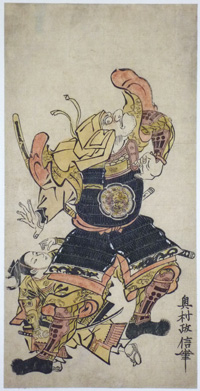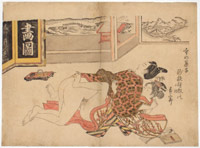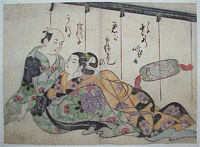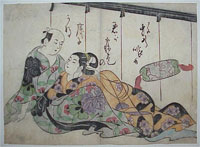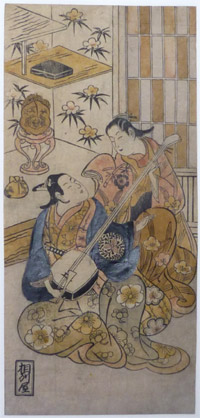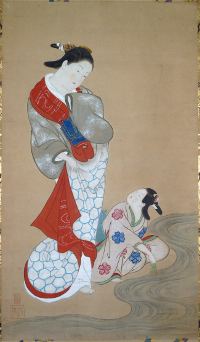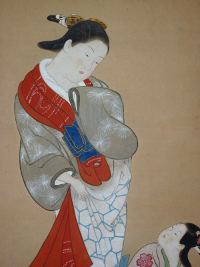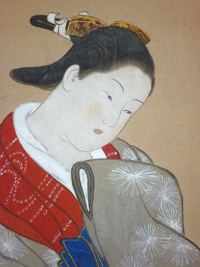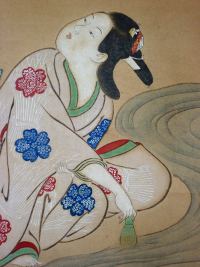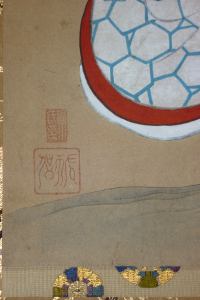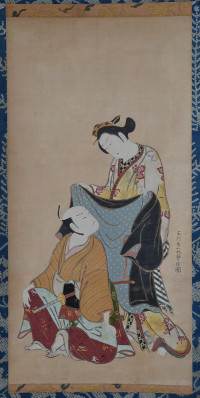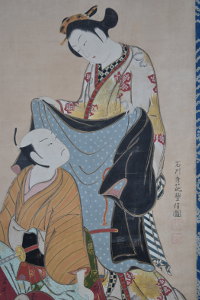Okumura MASANOBU (1686-1764)

Click here to view image full size.
One of the most influential and innovative print designers, publishers and painters. He is also credited with inventing the hashira-e as well as being the first to use multiple-block printing. A wide hashira-e (habahiro hashira-e, 24 x 6 in; 61 x 15 cms) showing the actor Sanogawa Ichimatsu I. Masanobu designed a number of prints showing this popular actor who started the fashion for the hisobi pattern on his costume which is now called the Ichimatsu moyo. Published by Masanobu c 1741. Rare.
Fine impression. Hand-applied colour: yellow, light red and light orange. Slight fading, otherwise very good condition. Signed Hogetsudo shomei Okumura Bunkaku Masanobu shohitsu, “Truly published by Hogetsudo and true brush by Okumura Masanobu” with seal Tanchosai.
Status: Available
Okumura MASANOBU (1686 -1764)
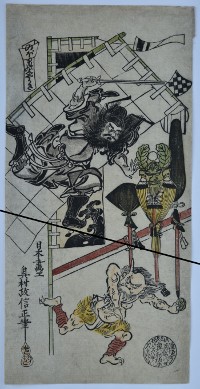
Click here to view image full size.
An hosoban showing banners for the Boy’s Festival held on the fifth day of the fifth month. These depicted Shoki, the Demon Quellor. One Shoki has come alive and leaps down from the banner to attack an oni – his traditional foe. At the top left on a small banner is the title: Nobori no Shoki, “Shoki the Devil-Quellor.” Masanobu was one of the most influential artists in Ukiyo-e. His long life covered hand-coloured prints through to full colour printing in the mid 1760s and he was one of the first to use the block-printing process after 1740 and pioneer the benizuri-e picture. Extremely innovative: he pioneered the uki-e print, pillar print and ishizuri-e. Not only was he a print artist, he also illustrated books, albums and produced paintings. He started his own publishing house, Okumuraya, which gave him greater control over the printing process. The popularity of his work led to many copies by other publishers, and he had to certify his work as being the “genuine” article. Published c 1725 by Tori-shio-cho, kongen Okumura hammoto. Kono ho no e nise han soro aida hyotan shirushi idashi soro. Provenance: Ex Schindler collection with seal au verso. See Masterpieces Of Ukiyoe-e Prints from The Schindler Collection, Nihon Keizai Shimbun Inc., 1985, no. 8, page 22. Extremely rare.
Very good impression and colour. Urushi: hand coloured with yellow, tan, green and sumi wash. Small edge repair top left, otherwise very good condition. Signed Nihon gwako Masanobu sho-hitsu with Okumura seal.
Status: Sold
Okumura MASANOBU (1686-1764)

Click here to view image full size.
An hashira-e showing Shoki, the Chinese demon queller, Chung Kwei, about to plunge a sword into an oni. Another pillar print showing Shoki from the same period is illustrated in The Clarence Buckingham Collection of Japanese Prints, The Primitives, Helen C. Gunsaulus, AIC, 1955, no. 103, p. 166. Published c. 1745. Rare.
Very good impression. A sumi-e, printed in sumi with washes of sumi applied by hand. Slight toning, otherwise very good condition.Pillar prints are often toned because they were hung and, of course, this is especially true of the earlier examples, as here. Signed Hogetsudo
Tanchosai Okumura Bunkaku Masanobu Baio ga with seal Tanchosai.
Status: Sold
Okumura MASANOBU (1686-1764)

Click here to view image full size.
The Fourth Month, Shibumukute toshimano mumami jukushi kaki, “Well Aged and Ripe Persimmon” from a set of 12 shunga prints Someiro no yama, Neya no hinagata, “Mountains of Dyed Colours, Patterns for the Bedroom.” One of the finest shunga sets; of large size and beautifully hand coloured. Published c. 1740. Others from the set are illustrated in Tim Clark, Shunga: Sex and Pleasure in Japanese Art, BM, 2013, p. 147-151. Masanobu is one of the most important figures in Ukiyo-e being the proprietor of a shop but also a publisher, an illustrator of books, print publisher, painter, and inventor of the hashira-e and uki-e as well as being at the forefront of advancements in colour printing. Rare.
Very good impression, colour and condition.
Status: Sold
Okumura MASANOBU (1686-1764)

Click here to view image full size.
The fifth month from a set of twelve prints Someiro no yama: Neya no hinagata, “Mountains of Dyed Colours: Patterns for the Bedroom.” A haiku poem relating to the time of year on each design. Published c. 1740. Shows a couple in flagrante in a room with sliding doors painted with images of Mount Fuji and the poet Ariwara no Narihira admiring the mountain. One of the great Shunga sets with fine contemporary hand-colouring: The careful colouring on impressions from this set was obviously carried out by skilled artisans and is exceptional with the sumi screens being almost painterly: Colouring is often later on early shunga prints, and even if contemporary can be slipshod. Masanobu was a great innovator, developing new formats and technical advances. Unidentified collector’s seal bottom left. Rare.
Very good impression. Slight weakening along laid lines, otherwise very good condition.
Status: Sold
Okumura MASANOBU (1686-1764)

Click here to view image full size.
A design from a set of twelve prints Someiro no yama: Neya no hinagata, “Mountains of Dyed Colours: Patterns for the Bedroom.” A haiku poem relating to the time of year on each design. Published c 1740. Shows a couple in flagrante in a room with a free-standing screen and a view outside of an engawa and garden with a stone water cistern. One of the great Shunga sets with fine contemporary hand-colouring: The careful colouring on impressions from this set was obviously carried out by skilled artisans and is exceptional with the sumi screen being almost painterly: Colouring is often later on early shunga prints, and even if contemporary can be slipshod. Masanobu was a great innovator, developing new formats and technical advances. Unidentified collector’s seal bottom right. A beautiful design. Rare.
Very good impression and condition.
Status: Sold
Okumura MASANOBU (1686-1764)
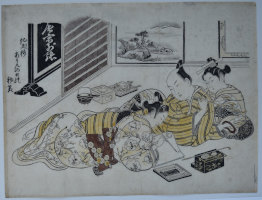
Click here to view image full size.
Shogatsu, “First Month” from a shunga set Someiro no yama neya no hinagata, “Mountains of Dyed Colours, Examples for the Bedroom.” Shows a New Year scene with the master of an opulent household enjoying the holiday with his wife and a young man of his fancy. The poem alludes to the pleasures of both male-male and male-female sex. Published c 1740. Others from the set are illustrated in Tim Clark, Shunga:Sex and Pleasure in Japanese Art, BM, 2013, pp. 147-151. Masanobu is one of the most important figures in Ukiyo-e being the proprietor of a shop but also a publisher, an illustrator of books, print publisher, painter, and inventor of the hashira-e and uki-e as well as being at the forefront of advancements in colour printing. Rare.
Fine impression. Hand colouring, slightly faded. Minor backed wormage, but otherwise very good condition given the date.
Status: Sold
Okumura MASANOBU (1686-1764)
Click here to view image full size.
A newly discovered painting by one of the most influential artist in Ukiyo-e. His long life covered hand-coloured prints through to full colour printing in the mid 1760s and he was one of the first to use the block-printing process after 1740 and pioneer the benizuri-e picture. Extremely innovative: he pioneered the uki-e print, pillar prints and ishizuri-e. Not only was he a print artist, he also illustrated books, albums and produced paintings. He started his own publishing house, Okumuraya, which gave him greater control over the printing process. The popularity of his work led to many copies by other publishers, and he had to certify his work as “genuine.” Shows a standing beauty, Tachi bijin-zu. She carries a cherry branch and her gorgeous costume is decorated with grasses and flowers with cages for collecting insects and above various colourful butterflies. Full colour on paper, image size 35.75 x 12.25 in; 91 x 31 cms. Fine new mount with futo-maki ( thick wooden roll to preserve the painting from damage ) and box. Fine condition. Ex collection Raizou Kanda. Signed Hogetsudo Tanchosai Okumura Masanobu with seals Masanobu and Okumura. Although long lived, genuine paintings by him are rare.
Status: Sold
Okumura MASANOBU (1686-1764)
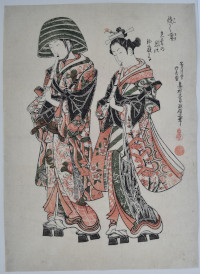
Click here to view image full size.
A large benizuri-e oban (16.75 x 12 in) showing a pair of lovers in the guise of komuso (medicant monks). They walk in high geta and have a black monk’s stole draped around their shoulders. They are playing the classic komuso tune renbo nagashi on their shakuhachi. He wears the deep sedge tengai hat. A hokku verse is on the right. Provenance: Ex collection Henri Vever, sealed bottom right. Sold Sothebys, Highly Important Japanese Prints from the Henri Vever Collection: Final Part, 30/9/1997, lot 6. Extremely rare: Probably the only recorded impression.
Very good impression and colour. Wormhole expertly repaired at right edge, otherwise very good condition. Signed Hogetsudo Tanchosai Okumura Bunkaku Masanobu shohitsu with two seals Tanchosai and Okumura Masanobu.
Status: Sold
Okumura MASANOBU (1686 – 1764)
Click here to view image full size.
A hosoban showing the fight between Ushiwaka Maru ( Yoshitsune ) and Benkei on Gojo Bridge ( 1170 ). Arguably the most influential figure in ukiyoe, reputedly being the innovator of colour printing. An urushi-e, coloured by hand in yellow, tan, lilac, gofun and heavy sumi over embossed lines. Published c 1725. Ex collections Tony Straus-Negbaur and Walter von Scheven ( 1878 – 1950 ) and purchased by him at Cassirer & Helbing, 1928, lot 64, ( from Tony Straus-Negbaur ). Extremely rare.
Very good impression. Slight soil and small repaired edge wormholes. But generally very nice condition for such an example. Signed Okumura Masanobu hitsu.
Status: Sold
Okumura MASANOBU (c.1686-1764)
Click here to view image full size.
A major artist attributed with the invention of the hashira-e and uki-e and who may have been the first to change from hand colouring to colour printing. Tera no kashi, “Sweets From a Temple” from Masanobu’s most highly regarded shunga set: Someiro no yama neya no hinagata, “Mountains of Dyed Colours, Examples of Bedrooms.” Published c. 1735. Sub-title: Sato Kosho sai, Kichisaburo. Shows a young monk copulating with a beauty in the vicinity of a temple. Hence the punning title. Four other illustrations from this set illustrated in Shunga, Tom and Mary Evans, 1975, 5.64 – 5.67. Extremely rare.
Very good impression. Careful contemporary hand colouring ( as all prints for this series ). The red pigment with gum added. Centre fold ( as per usual ) with repair at top edge. Slight soil, otherwise very good condition for this period. Unsigned.
Status: Sold
Okumura MASANOBU (1686-1764)
Click here to view image full size.
A pair of lovers. Obviously one sheet from a shunga album. A sumizuri-e print with careful hand-colouring. Although possibly not contemporary the colouring certainly has considerable age. Published c 1710s.
Very good impression. Slight offsetting of sumi and other minor soil and backed wormholes. Centre fold.
Status: Sold
Okumura MASANOBU (1686-1764)
Click here to view image full size.
A pair of lovers. Obviously one sheet from a shunga album. A sumizuri-e print with careful hand-colouring. Although possibly not contemporary the colouring certainly has considerable age. Published c 1710s.
Very good impression. Slight offsetting of sumi and other minor soil and backed wormholes. Centre fold.
Status: Sold
Okumura TOSHINOBU (active c. 1717-1750)
Click here to view image full size.
A hosoban showing an interior scene with the actor Ogino Isaburo I ( 1703-48 ), seated and playing a shamisen with a plectrum. Behind him is a courtesan, one hand on the shamisen. Toshinobu may have been the adopted son of Okumura Masanobu. Published by Soshu ( Sagami ) – ya c. 1725-30.
Good impression. Nice hand colouring with beni, mustard, yellow, blue and the addition of gum and gold powder ( bronze or brass ). Slight toning and loss of gold. Unsigned.
Status: Sold
Nishikawa SUKENOBU (1671-1750)
Click here to view image full size.
The pre-eminent painter in the Kyoto area during the first half of the eighteenth century. He enjoyed a great reputation in his lifetime and his (over 100) illustrated books influenced many artists, not only in the Kyoto-Osaka area but also in Edo. Many of his books were published by Hachimonjiya in Kyoto such as Hyakunin joro shina sadame (1723). Other famous books being: Tokiwa gusa (1731); Asakayama (1739); Chiyomi-gusa (1740). His paintings were collected by his contemporaries with Yanagisawa Kien (in his Hitorine, c. 1726) calling him the “supreme master” of Ukiy-e, superior to Okumura Masanobu, Torii Kiyonobu, Hanekawa Chincho and Kaigetsudo. Full colour on silk, 30.25 x 17.5 in; 76.7 x 44.3 cms. Shows a typically refined and elegant beauty watching her assistant washing a tea-whisk in a stream. Suihen bijin zu. There are two other versions of this design by Sukenobu: One was auctioned in 1933 at the Osaka Art Club from the W. Sturgis collection and there is another from Nagano, Japan, illustrated in Kokka, no. 18, 2011, p. 10. Other examples are in major museums such as the Metropolitan, Philadelphia, Freer, Honolulu, British, etc. Although Sukenobu produced many paintings, genuine works are now rare. Painted c late 1730s. Minor marks and creases and some loss of gofun, but in very good condition for an early 18th century painting. Sealed Nishikawa shi in and Sukenobu. Illustrated and exhibited in Nikuhitsu Ukiyoe Beauty, Tokyo Fuji Art Museum, 1983, no. 21, ex Hirano collection, Akita Prefecture.
Very good condition. Signed and sealed Bokusen. See my Blog on this update.
here
Status: Sold
Ishikawa TOYONOBU (1711-1785)

Click here to view image full size.
A very fine original painting, sumi and colour on paper with extensive laquer and a large emossed gold floral pattern on the bijin’s kimono; other areas in gold. Image size 35.25 x 17.75 in; 89.5 x 45 cms. Shows an elegant beauty holding up an haori to slip it over the shoulders of a seated nobleman. There is a great feeling of tenderness between the couple in this beautiful painting. In fact Toyonobu produced a print of this exact subject but showing the actors Nakamura Kiyosaburo I as Okiku and Ichimura Kamezo I as Kosuke, a pair of lovers, who were in the play Fujito nikki in 7/1751. Toyonobu must have liked the design and produced this painting but of just the protagonists. See this link in google
for the published print.
Toyonobu was a pupil of Nishimura Shigenaga and his style is also indebted to Okumura Masanobu. Produced some of the most exquisite kakemono-e, hashira-e and large obans of this period which, when they come onto the market, fetch considerable sums of money. (See, for example, Christies auction, N.Y., 18/9/2002, lot 6, ex Vever collection.) For a fine collection of his work, see The Clarence Buckingham Collection of Japanese Prints. The Primitives, 1955, A.I.C., pp. 199 – 229, nos. 1 – 58. Signed Ishikawa Shuha Toyonobu zu with seals Ishikawa uji and Toyonobu. Illustrated in colour in the exhibition catalogue of the Fuchu Art Museum, Artists of the Three Capitals-Learning About Edo Through Kyoto and Osaka, Kaneko, Nobuhisa, Oto, Yumiko, 2012, No. 67, p. 92. The cataloguing gives the play as Hiyoku no kagamon but this is most likely a dance that served as the finale. Hiyoku can mean “wings abreast” and hiyoku no tori, the “hiyoku birds” were a mythical couple who shared a single pair of wings, i.e. two lovers. In fine condition, especially given the age. Painted c. 1751.
Status: Sold
MANGETSUDO (Active 1743-1747)
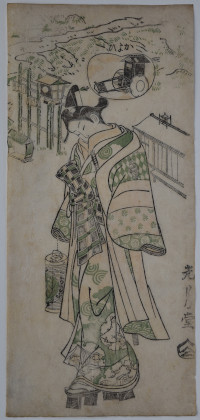
Click here to view image full size.
An hosoban showing a youth impersonated by Onoe Kikugoro I standing outside the Yoshiwara. Above is a cartouche showing a gosho-guruma (a mid-17th century Imperial cart) and above the cartouche the word Kayoi: An allusion to the story of Shosho visiting Komachi. This is the right sheet of a triptych with title Yoshiwara Komachi sambukutsui, “Komachi of the Yoshiwara, Set of Three.” (See Hayashi catalogue, 1902, no. 325 for the complete triptych.) Another impression is illustrated in The Clarence Buckingham Collection Of Japanese Prints, The Primitives, AIC, p. 183, which lacks signature and publisher’s seal. Published by Okumuraya, c 1740. Nothing is known about Mangetsudo, other than he was a follower of Masanobu.
Very good impression. Some fading, otherwise good condition. Signed Mangetsudo.
Status: Sold
Artists
( A to Z )
Kyogado ASHIKUNI ( Fl. c. 1807 – 1818 )
Gigado ASHIYUKI ( Fl. c. 1814 – 1833 )
Ki BAITEI ( 1734 – 1810 )
Takizawa BAKIN ( 1767 – 1848 )
Ono BAKUFU ( 1888 – 1976 )
Georges BIGOT ( 1860 – 1927 )
Kawamura BUMPO ( 1779 – 1821 )
Ippitsusai BUNCHO ( Fl. c. 1765 – 1792 )
Toyohara CHIKANOBU ( 1838 – 1912 )
Kishi CHIKUDO ( 1826 – 1897 )
Tsubaki CHINZAN ( 1801 – 1854 )
Eishosai CHOKI ( Fl. c. 1756 – 1808 ). See also SHIKO
Rekisentei EIRI ( Fl. c. 1790 – 1800 )
Keisai EISEN ( 1790 – 1848 )
Hosoda EISHI ( 1756 – 1829 )
Hosoda EISHO ( Fl. c. 1780 – 1800 )
Ichirakutei EISUI ( Fl. c. 1790 – 1823 )
Kikugawa EIZAN ( 1787 – 1867 )
Hirano HAKUHO ( 1879 – 1957 )
Elizabeth KEITH ( 1887 – 1956 )
Imao KEINEN ( 1845 – 1924 )
Yashima GAKUTEI ( 1786 – 1868 )
Ogata GEKKO ( 1859 – 1920 )
Adachi GINKO ( Fl. c. 1847 – 1897 )
Matsumura GOSHUN ( 1752 – 1811 )
GYOSAI. See Kawanabe KYOSAI
Hirano HAKUHO ( 1879 – 1957 )
Suzuki HARUNOBU ( 1724 – 1770 )
Kawase HASUI ( 1883 – 1957 )
Kitagawa HIDEMARO ( Fl. c. early 19th century )
Kinoshita HIRONOBU ( Fl. c. 1851 – 1870 )
Gosotei HIROSADA ( Fl. c. 1847 – 1863 )
Ichiryusai HIROSHIGE ( 1797 – 1858 )
Ichiryusai HIROSHIGE II ( 1826 – 1869 )
Ando HIROSHIGE III ( 1843 – 1894 )
Nakamura HOCHU ( Fl. c. late 18th to early 19th century )
Sakai HOITSU ( 1761 – 1828 )
Totoya HOKKEI ( 1780 – 1850 )
Teisai HOKUBA ( 1771 – 1844 )
Shunkosai HOKUEI (Active 1824-1837)
Katsushika HOKUGA ( Fl. c. 1830 )
Shotei HOKUJU ( Fl. c. 1789 – 1818 )
Katsushika HOKUSAI ( 1760 – 1849 ). Also used numerous other names such as: SORI, SHUNRO, SHINSAI
Shokosai HOKUSHU ( Fl. c. 1808 – 1832 )
KEISAI. See Kitao MASAYOSHI
Suzuki KIITSU ( 1796 – 1858 )
Kitagawa KIKUMARO ( Fl. c. ? – 1830 ). See TSUKIMARO
Kobayashi KIYOCHIKA ( 1847 – 1915 )
Torii KIYOHIRO ( Fl. c. 1737 – 1771 )
Torii KIYOMASA ( Fl. c. 1700 – 1722 )
KIYOMINE. See Torii KIYOMITSU II
Torii KIYOMITSU ( 1735 – 1785 )
Torii KIYOMITSU II ( 1787 – 1868 ). See KIYOMINE
Torii KIYONAGA ( 1752 – 1815 )
Torii KIYONOBU ( 1664 – 1729 )
Torii KIYONOBU II ( 1706 – 1763 )
Torii KIYOTSUNE ( Fl. c. 1757 – 1779 )
Isoda KORYUSAI ( Fl. c. 1767 – 1788 )
Ohara KOSON ( 1877 – 1945 ). See SHOSON
Torii KOTONDO ( 1900 – 1976 )
Toyohara KUNICHIKA ( 1835 – 1900 )
Utagawa KUNIHIRO ( Fl. c. 1815 – 1843 )
Ichiunsai KUNIHISA ( 1832 – 1891 )
Utagawa KUNINAO ( 1793 – 1854 )
Utagawa KUNISADA ( 1786 – 1865 )
Utagawa KUNISADA II ( 1823 – 1880 )
Utagawa KUNISATO ( ? – 1858 )
Utagawa KUNITERU ( 1808 – 1876 )
KUNITERU. See Utagawa SADASHIGE
Utagawa KUNITERU II ( 1829 – 1874 )
Utagawa KUNIYASU ( 1794 – 1832 )
Ichiyusai KUNIYOSHI ( 1797 – 1861 )
Santo KYODEN. See Kitao MASANOBU
Kawanabe KYOSAI ( 1831 – 1889 ). See GYOSAI
Okumura MASANOBU ( 1686 – 1764 )
KitaoMASANOBU ( 1761 – 1816 ). See Santo KYODEN
Kitao MASAYOSHI ( 1764 – 1824 ). See KEISAI
Oishi MATORA ( 1794 – 1833 )
Hishikawa MORONOBU ( Fl. c. 1618 – 1694 )
Nishimura NANTEI ( 1775 – 1834 )
Utagawa NOBUKATSU ( Fl. c. 1830 – 1844 )
Watanabe NOBUKAZU ( Fl. c. late 19th century )
Hishikawa RYUKOKU ( Fl. c. 1808 – 1816 )
Jokei RYUKOSAI ( Fl. 1772 – 1816 )
Gokitei SADAFUSA ( Fl. c. 1825 – 1850 )
Hasegawa SADAHARU ( Fl. c. 1830 – 1844 )
Gokotei SADAKAGE ( Fl. c. 1818 – 1844 )
Utagawa SADAHIDE ( 1807 – 1873 )
Hasegawa SADANOBU ( 1809 – 1879 )
Utagawa SADASHIGE ( Fl. c. mid 19th century ). See KUNITERU
Gofutei SADATORA ( Fl. c. 1825 )
Yamaguchi SHIGEHARU ( 1803 – 1853 )
Kitao SHIGEMASA ( 1739 – 1820 )
Nishimura SHIGENAGA ( 1697 ? – 1756 )
Nishimura SHIGENOBU ( Fl. c. 1724 – 1735 )
SHIKO. See Eishosai CHOKI
Ryuryukyo SHINSAI ( 1764 – 1820 )
Ito SHINSUI ( 1898 – 1972 )
Kojima SHOGETSU ( Fl. c. 1880 – 1890 )
SHOSON. See Ohara KOSON
Takahashi SHOTEI ( 1871 – 1945 )
Yamamoto SHOUN ( 1870 – 1965 )
Yamakawa SHUHO ( 1898 – 1944 )
Katsukawa SHUNCHO ( Fl. c. 1780 – 1795 )
Takehara SHUNCHOSAI ( Fl. c. 1772 – 1801 )
Katsukawa SHUN’EI ( 1762 – 1819 )
Katsukawa SHUNKO ( 1743 – 1812 )
Hishikawa SHUNKYO ( Fl. c. early 19th century )
Kubo SHUNMAN ( 1757 – 1820 )
Katsukawa SHUNSEN ( Fl. c. 1762 – 1830 )
Natori SHUNSEN ( 1886 – 1960 )
Gatoken SHUNSHI ( Fl. c. 1820 – 1828 )
Katsukawa SHUNSHO ( 1726 – 1792 )
Katsukawa SHUNTEI ( 1770 – 1820 )
Katsukawa SHUNZAN ( Fl. c. 1782 – 1798 )
Yamaguchi SOKEN ( 1759 – 1834 )
Ikeno TAIGA ( 1723 – 1776 )
Katsukawa TERUSHIGE ( Fl. c. 1715 – 1725 )
Mori TETSUZAN (1775-1841)
Migita TOSHIHIDE ( 1863 – 1925 )
Mizuno TOSHIKATA ( 1866 – 1908 )
Okumura TOSHINOBU ( Fl. c. 1717 – 1750 )
Utagawa TOYOHARU ( 1735 – 1814 )
Utagawa TOYOHIRO ( 1773 – 1828 )
Utagawa TOYOKUNI ( 1769 – 1825 )
Utagawa TOYOKUNI II ( 1777 – 1835 ). See TOYOSHIGE
Yamamura TOYONARI ( 1885 – 1942 )
Ishikawa TOYONOBU ( 1711 – 1785 )
TOYOSHIGE. See Utagawa TOYOKUNI II
TSUKIMARO. See Kitagawa KIKUMARO
Kitano TSUNETOMI ( 1880 – 1947 )
Toyokawa UMEKUNI ( Fl. c. 1816 – 1826 )
Kitagawa UTAMARO ( 1753 – 1806 )
Kitagawa UTAMARO II ( ? – 1831 )
Inoue YASUJI ( 1864 – 1889 )
Hiroshi YOSHIDA ( 1876 – 1950 )
Ipposai YOSHIFUJI ( 1828 – 1887 )
Utagawa YOSHIIKU ( 1833 – 1904 )
Utagawa YOSHIKATA ( Fl. c. 1841 – 1864 )
Utagawa YOSHIKAZU ( Fl. c. 1850 – 1870 )
Toyokawa YOSHIKUNI ( Fl. c. 1803 – 1840 )
Utagawa YOSHIMUNE ( 1817 – 1880 )
Ichiyosai YOSHITAKI ( 1841 – 1899 )
Utagawa YOSHITORA ( Fl. c. 1850 – 1880 )
Taiso YOSHITOSHI ( 1839 – 1892 )
Utagawa YOSHITSURU ( Fl. c. 1840 – 1850 )
Ichieisai YOSHITSUYA ( 1822 – 1866 )
Mori YOSHIYUKI ( 1835 – 1879 )
Shibata ZESHIN ( 1807 – 1891 )
